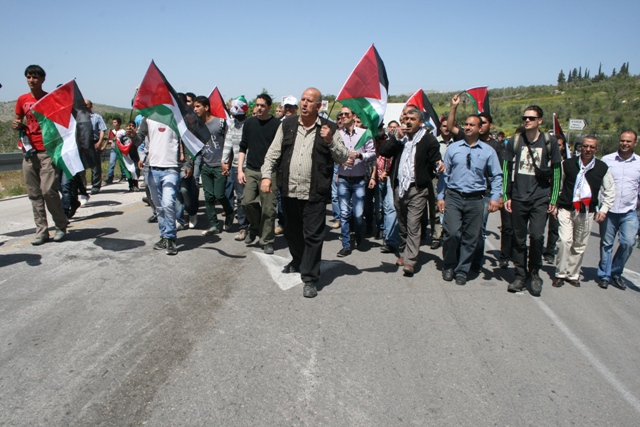About 100 Palestinians from the ancient village of Sebastia and their supporters held a demonstration today to protest against settlers spilling their sewage onto the village’s agricultural lands. This was the third demonstration in two months; villagers are starting weekly demonstrations, much like the ones against the wall and settlements that take place every Friday in Bil’in, Ni’ilin, Ma’asara, Nabi Saleh and Qaddum. Demonstrations took place in all of those villages as well on Friday, some of them with violent confrontations with army forces. In addition, activists in the newly formed popular committee say they are planning to take the matter to the Supreme Court.
Demonstrators convened in the center of the village at around noon and were joined by Palestinian MP Mustafa Barghouti (of the Mubadara party), activists from the Popular Front for the Liberation of Palestine, some from popular committees in other villages and Israeli and international solidarity activists. Several speakers talked about the sewage, that since December has been flowing into their fields from the nearby settlement of Shavei Shomron. However, they also explained that the sewage was only one symptom of the occupation, alongside land grabs, uprooting of trees, limitations on freedom of movement and they stressed that the protest was against the occupation as a whole.
“Settlers offered [to] avoid spilling the sewage onto our lands if we let them connect to our sewage system,” explained Ahmed Qaid, a computer engineer, football trainer and activist in the popular committee. “We refused because they are sitting on lands that were stolen from us and four neighboring villages, and we want them out of our lands – not to welcome them and offer them use of our infrastructure.”
After marching and chanting for about 15 minutes, demonstrators arrived at the field where a small stream of sewage water was running and the settlement was visible. They were met by some 20 soldiers, who declared the area a closed military zone and said the demonstrators had 25 minutes to disperse. After praying on the land, demonstrators started marching toward the settlement and were met with tear gas grenades, which were soon after answered by stones from the village youth.
It seemed, however, that both sides were trying to prevent things from escalating, and within about half an hour the demonstration ended. One teenager was slightly injured by a rubber bullet and one international was captured by soldiers, only to be “de-arrested” later by his friends. The demonstration also commemorated Palestinian Land Day (March 30), a national day of struggle against land expropriations.
With its 4,500 inhabitants, the village of Sebastia is strategically located on a mount in the heart of a plain surrounded by hills. It is this perfect location that attracted empires of old, relics of which can still be found throughout the village. In Israelite times (around the 8th and 9th centuries BC) the village was known as Shomron (Samaria) and was the capital of the Israelite Kingdom (while Jerusalem remained the heart of Judea). The Israelite palace, a Roman temple, a Greek theater and a Byzantine church are all found at the top of a hill.
The historic site is regularly visited by Palestinian and foreign tourists. Since it was proclaimed an Israeli national park, settlers go there several times a year with soldiers serving as their security units. Just yesterday, 500 settlers made use of the Passover holiday and camped in the site, while soldiers prevented Palestinian entry to it. Sebastia was also the first place where attempts were made to build a settlement; an attempt which failed eventually but led to the founding of the Kedumim and Shavei Shomron settlements on nearby lands.







